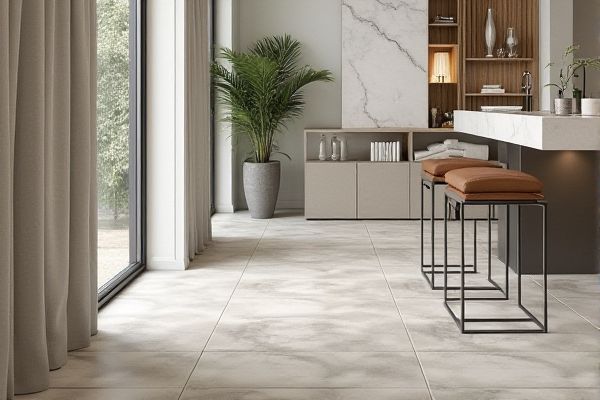
Large format tile offers a sleek, modern look with fewer grout lines, making spaces feel larger and easier to clean than mosaic tile, which provides intricate patterns and greater design flexibility for accent walls or backsplashes. Discover how choosing between large format and mosaic tile can impact your home's style and functionality by reading the rest of the article.
Table of Comparison
| Feature | Large Format Tile | Mosaic Tile |
|---|---|---|
| Tile Size | Typically 15x15 inches or larger | Small tiles, usually 2x2 inches or smaller |
| Installation | Requires skilled labor, fewer grout lines | More labor-intensive, numerous grout lines |
| Visual Impact | Modern, sleek, creates spacious feel | Decorative, detailed, adds texture |
| Grout Lines | Minimal, easier maintenance | Many, requires frequent cleaning |
| Application | Floors, large walls, commercial spaces | Backsplashes, showers, accent walls |
| Durability | Highly durable, ideal for high-traffic areas | Durable but more susceptible to grout wear |
| Cost | Higher material and installation cost | Generally lower material cost, higher labor cost |
Introduction to Tile Types: Large Format vs Mosaic
Large format tiles, typically measuring 15 inches or more on one side, offer a sleek, contemporary look with fewer grout lines, enhancing visual flow in spacious areas. Mosaic tiles consist of small pieces, often less than 2 inches, arranged in intricate patterns, providing design flexibility and detailed texture ideal for accents or smaller spaces. Choosing between large format and mosaic tiles depends on the desired aesthetic, space size, and installation complexity.
Key Differences Between Large Format and Mosaic Tiles
Large format tiles typically measure 15x15 inches or larger, offering a sleek, seamless look with fewer grout lines, ideal for creating spacious and modern aesthetics. Mosaic tiles consist of smaller pieces, often under 2 inches, arranged in patterns or sheets, providing intricate designs and greater flexibility for curved surfaces or detailed applications. Your choice between large format and mosaic tiles depends on the desired visual impact, installation area, and maintenance preferences, as larger tiles require more precise leveling while mosaics offer enhanced texture and grip.
Aesthetic Impact: Visual Appeal and Design Versatility
Large format tile enhances your space with a sleek, seamless look that creates the illusion of a more expansive area, ideal for modern and minimalist designs. Mosaic tile offers intricate patterns and vibrant color combinations, providing high design versatility perfect for adding texture and artistic detail. Both options transform your interiors, but your choice depends on whether you prefer bold simplicity or decorative complexity for visual appeal.
Installation Process: Complexity and Considerations
Large format tile installation demands precise surface preparation and specialized tools to manage heavy, oversized pieces, ensuring even alignment and preventing lippage. Mosaic tile installation, while less physically demanding, requires meticulous grout work and careful placement of numerous small pieces to achieve uniform spacing and pattern consistency. Both tile types necessitate different skill sets and time investments, influencing project complexity and cost considerations.
Maintenance and Cleaning Requirements
Large format tiles require less grout cleaning due to fewer grout lines, making maintenance simpler and reducing the risk of mold and mildew buildup. Mosaic tiles have more grout lines, demanding frequent cleaning and sealing to prevent dirt accumulation and discoloration. Choosing large format tiles can significantly lower long-term upkeep efforts in high-traffic or moisture-prone areas.
Durability and Longevity
Large format tiles offer superior durability and longevity due to fewer grout lines, reducing the risk of cracking and water infiltration compared to mosaic tiles. Mosaic tiles, while visually versatile, often require more maintenance because their numerous grout joints can accumulate dirt and are more prone to wear over time. Choosing large format tiles ensures a robust and long-lasting surface ideal for high-traffic areas.
Cost Comparison: Materials and Labor
Large format tiles generally cost more per square foot than mosaic tiles due to their size and manufacturing complexity, but they require less grout and fewer seams, which can reduce labor expenses. Mosaic tiles, often priced lower per unit, can increase installation time and labor costs because of their intricate patterns and numerous grout lines. Overall, the combined material and labor costs for large format tiles tend to be more economical for expansive surfaces, whereas mosaic tiles may incur higher total installation costs despite lower material prices.
Ideal Applications for Large Format Tile
Large format tiles are ideal for spacious areas such as living rooms, commercial lobbies, and open-concept kitchens, where fewer grout lines create a seamless, elegant look. Their size enhances the perception of space and simplifies maintenance, making them suitable for both residential and commercial applications. You can achieve a modern and clean aesthetic by choosing large format tiles for floors, walls, and even outdoor patios.
Best Uses for Mosaic Tile
Mosaic tile excels in creating intricate patterns and detailed designs, making it ideal for backsplashes, shower floors, and decorative accent walls in kitchens and bathrooms. Its small size allows for easy installation on curved or uneven surfaces, providing both aesthetic appeal and slip resistance. Mosaic tile's versatility and vibrant color options make it perfect for adding texture and visual interest in smaller, high-impact areas.
Choosing the Right Tile for Your Space
Large format tiles create a sleek, spacious appearance with fewer grout lines, making them ideal for modern, open areas and enhancing the flow of your space. Mosaic tiles offer intricate patterns and textures, perfect for adding visual interest and detail in smaller areas or accent walls. Your choice depends on the scale of the room and the desired aesthetic effect, balancing ease of maintenance with design impact.
 homyna.com
homyna.com